Receive reminders like "Stay hydrated! You've only consumed two glasses today; aim for at least 8 for proper hydration."? Such health and fitness apps play a crucial role in maintaining well-being amidst daily routines.
The global fitness app market, valued at USD 38.66 billion in 2023, is projected to surge to USD 66.08 billion.
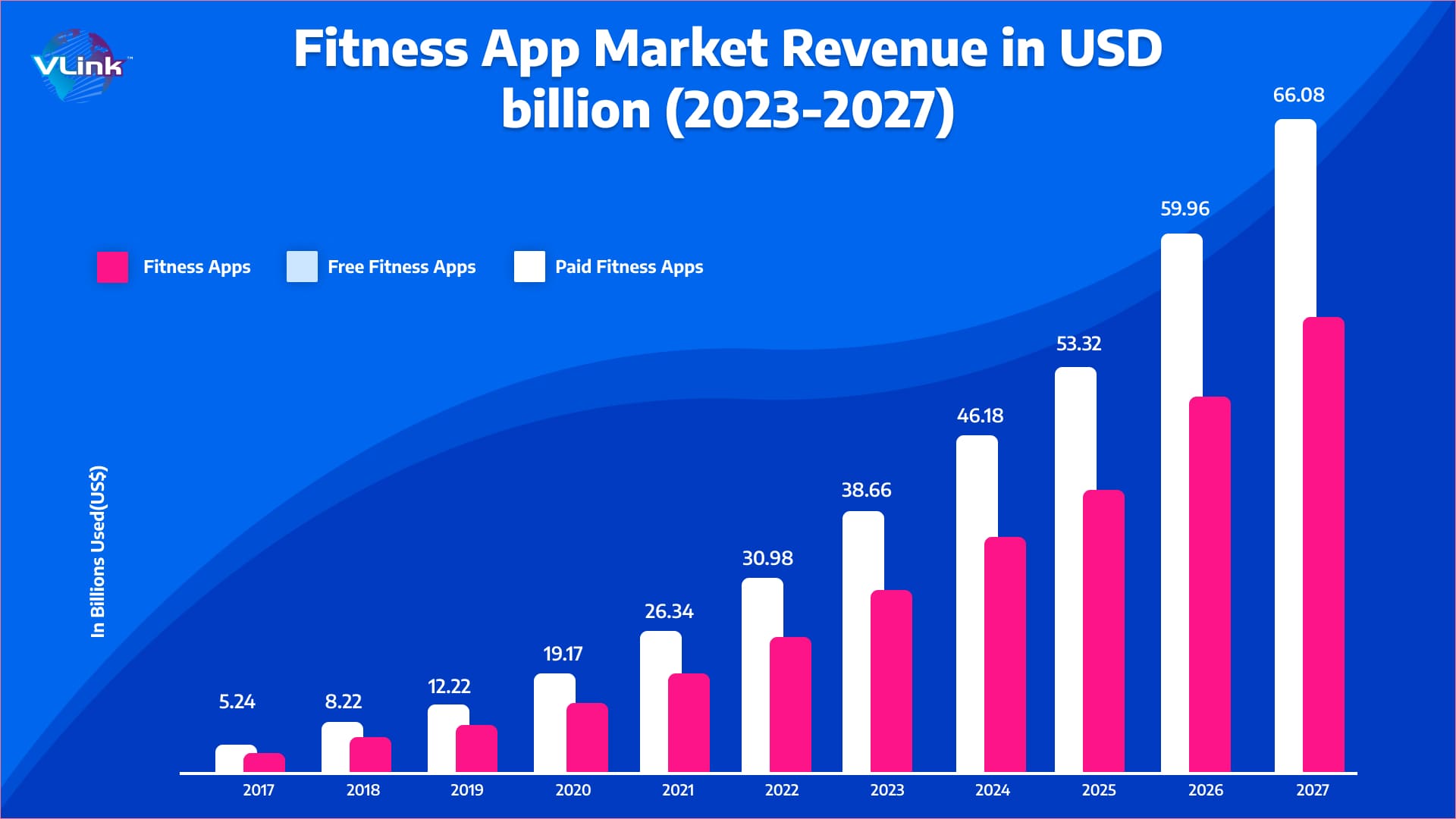
By 2024, an estimated 119 million Americans will use eServices apps, and 39.6 million will opt for eServices wearables, highlighting the industry's robust growth. Currently, about 19% of smartphone users have at least one health-tracking app covering various aspects like diet, exercise, and nutrition.
There are several fitness & nutrition apps available in the market, such as MyFitnessPal, Fitbit, Strava, and many more. MyFitnessPal is a leading fitness and sports mobile app, generating in-app revenues of almost 12 million U.S. dollars.
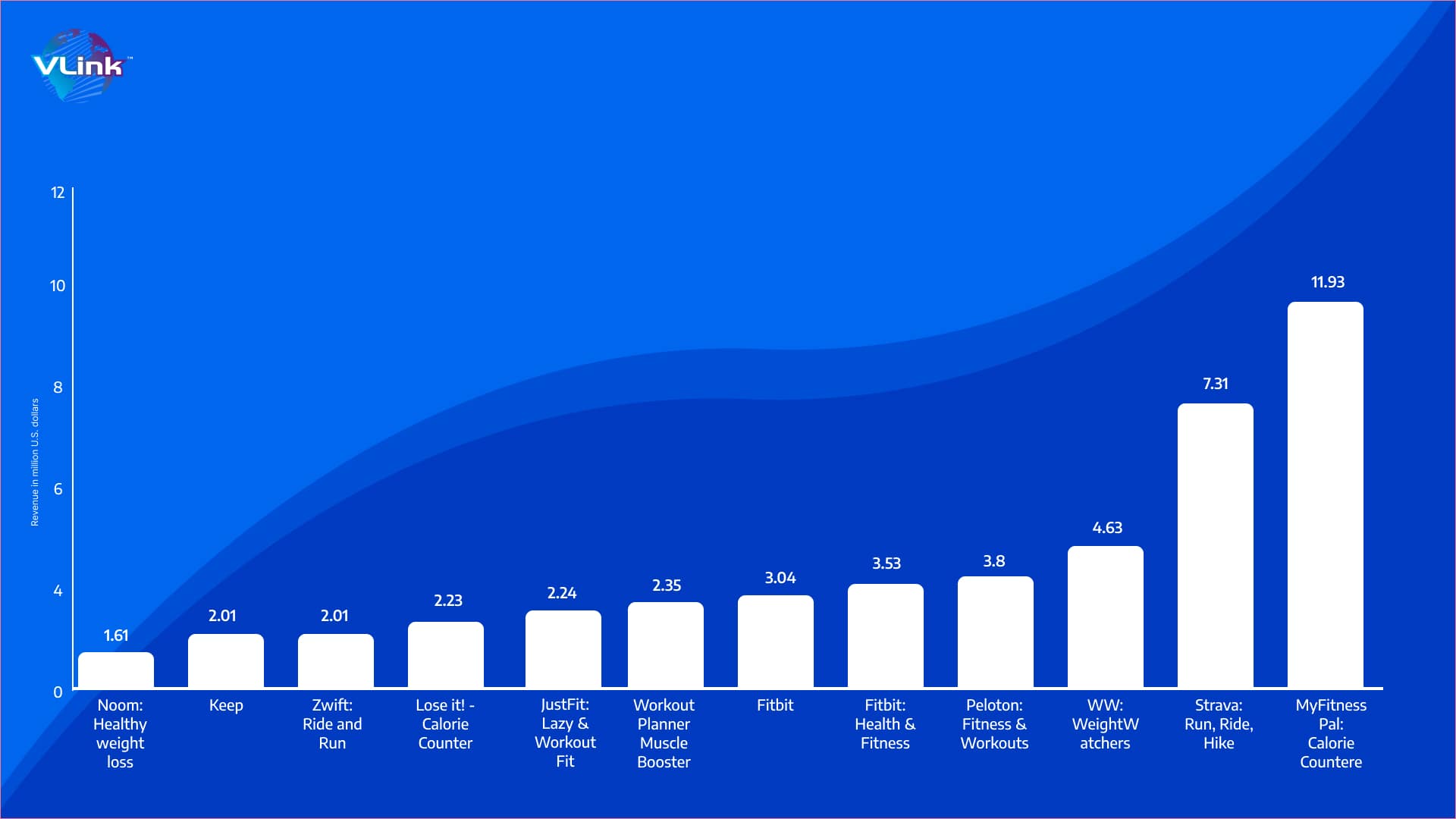
If you are planning to build a fitness app like MyFitnessPal, you are on the right path!
In this blog, we will explore incredible stats, features, steps, and costs for the development of a MyFitnessPal-like fitness app.
A Quick Glimpse: MyFitnessPal
MyFitnessPal shines as a guiding light in the health and wellness landscape, fundamentally transforming the way millions embark on their fitness endeavors. With a history spanning over a decade, this app has emerged as an unwavering companion for those dedicated to fostering healthier lifestyles. MyFitnessPal stands out as a versatile tool, providing users with a robust set of features to seize control of their well-being.
Surpassing a staggering 200 million users, the app serves as a comprehensive hub for tracking nutrition, exercise, and overall health. Its user-friendly interface facilitates seamless logging of meals, calorie counting, and macronutrient monitoring.
Leveraging a vast food database, users can effortlessly input items through barcode scanning or manual entries, gaining immediate insights into their dietary patterns.
MyFitnessPal transcends mere calorie tracking by seamlessly integrating with diverse fitness devices, promoting a holistic approach to health. The community-centric feature encourages users to share achievements, seek advice, and maintain motivation throughout their fitness journeys.
As MyFitnessPal commemorates its enduring legacy, its ongoing evolution and unwavering dedication to user-driven innovation affirm its pivotal role as a catalyst for positive transformations in the realm of personal fitness.
Why Should You Invest in Fitness App Development? Interesting Numbers!
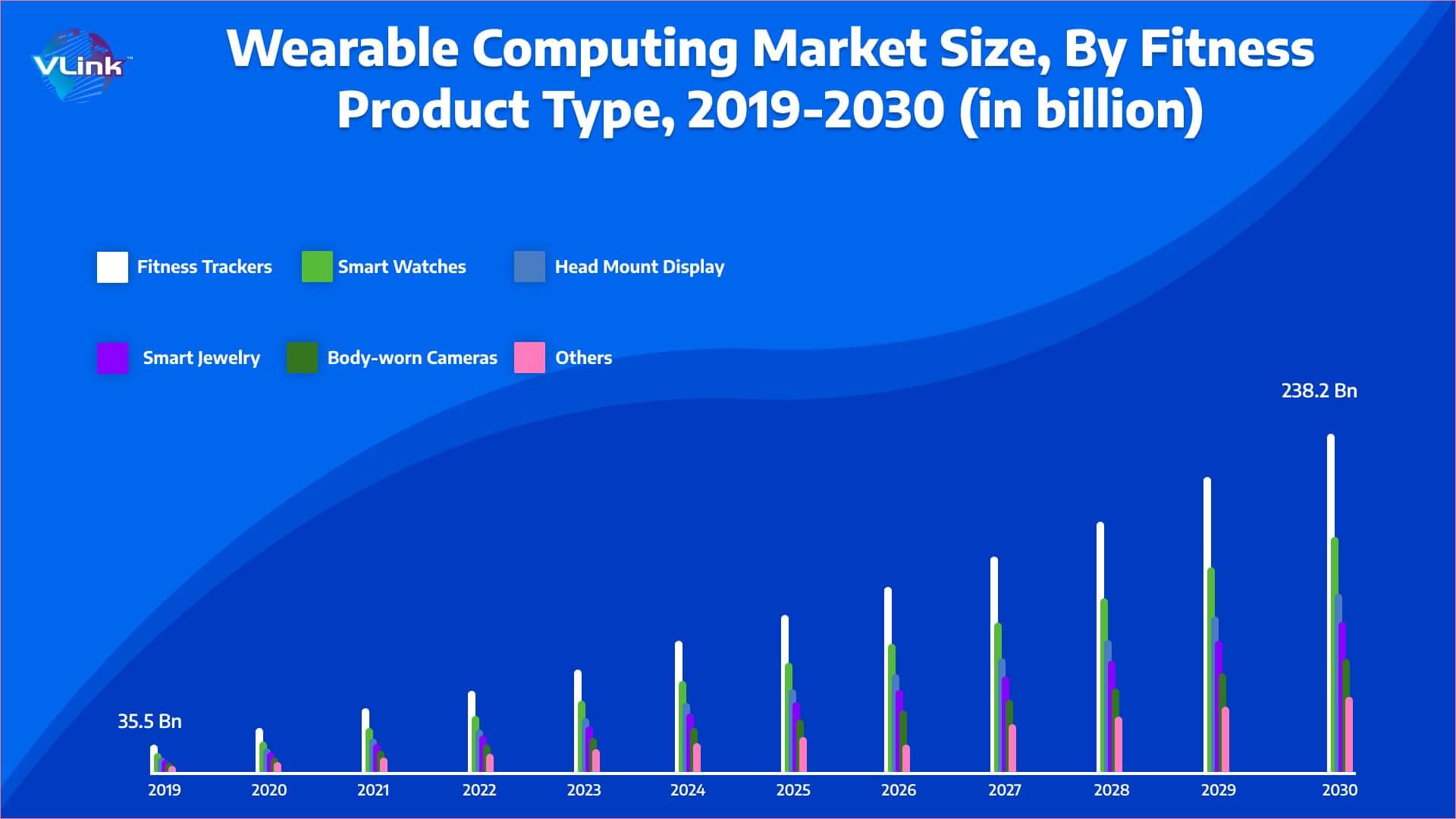
According to a Statista report, the anticipated global revenue from fitness apps is projected to hit $15.2 billion by the year 2028.
Projected to surge from $8.21 billion in the previous year, the revenue in the health sector is anticipated to reach $35.7 billion by the year 2030.
The Global Wearable Computing Market size is expected to reach $238.2 billion by 2030, rising at a market growth of 19.6% CAGR during the forecast period.
Fitness apps were downloaded more than 400 million times between 2022 and 2023.
Approximately 19% of smartphone users have a health-tracking app encompassing areas such as diet, exercise, nutrition, and more.
Features of MyFitnessPal, Like Fitness & Nutrition App
Features of MyFitnessPal Like, a Fitness app for admin and customers, are below in the table:
Features for Admin | Features for Customers |
| Registration/ Login | Login |
| User Profile | Manage Dashboard |
| Link Wearable | Manage Users |
| Track Activity/Diet/Sleep | Manage Pyaments |
| View Diet Plans | Manage Plans |
| View/Manage Health records | Manage Notifications |
| Payment Gateways | Manage Promo and offers |
| View Daily Progress Report | Manage Media -Video and Images |
| View/Track your steps | Manage Rewards
|
| View Health Tips/Suggestions | Manage Subscription |
| Push Notification |
Must-Have Features of MyFitnessPal Like Fitness App
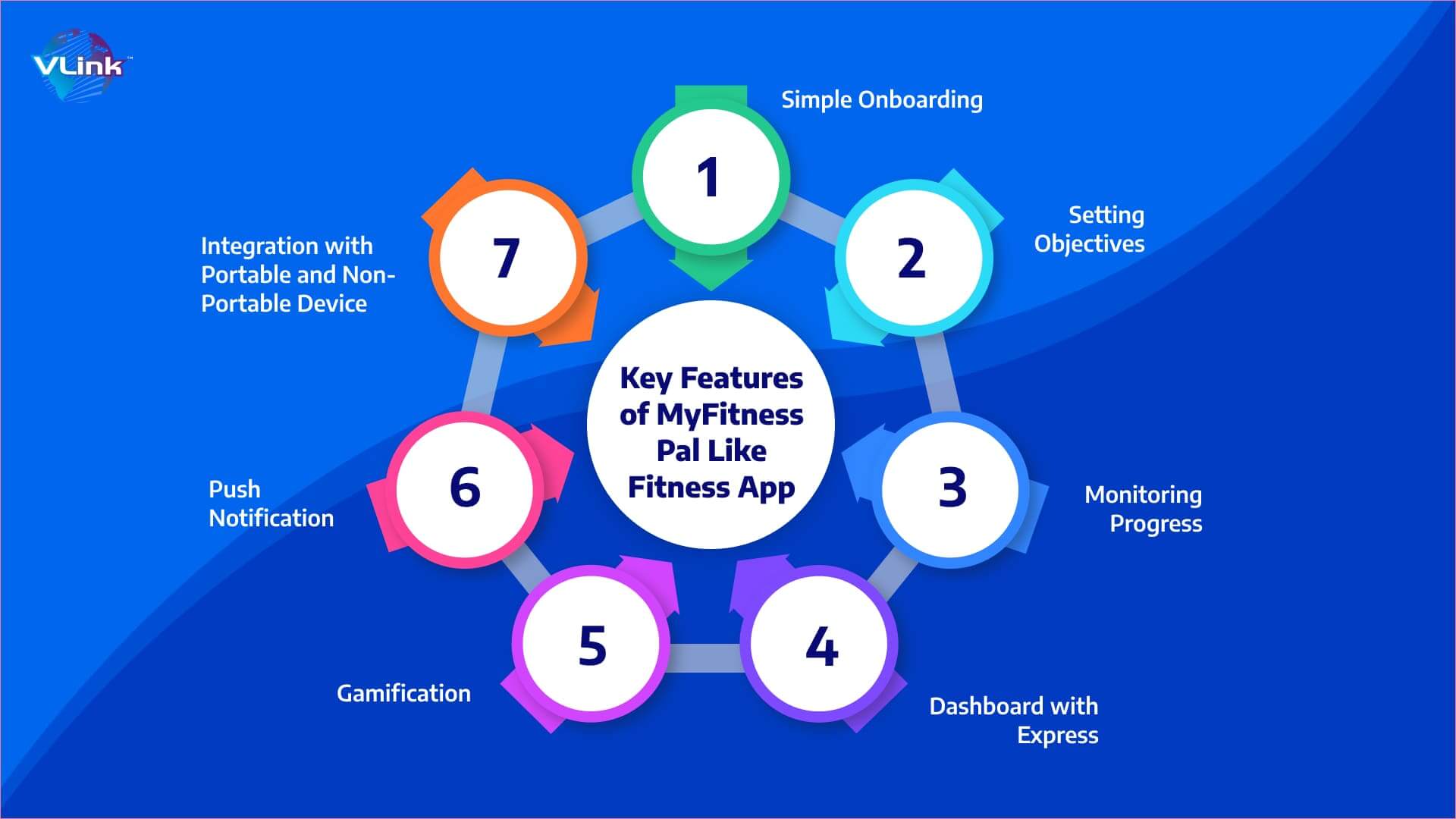
The registration and login process for the app should be user-friendly, allowing users to quickly sign up or log in by integrating social media accounts or providing their mobile phone number or email address.
Once registered, accessing the application on the same device should require just a single tap for a seamless login experience. Additionally, onboarding personal trainers for the fitness app should be a straightforward process.
Individuals download fitness and nutrition apps with the aim of achieving fitness and well-being. Many users have specific objectives such as weight loss, managing health conditions, or maintaining overall health.
Incorporating a feature that empowers users to define their own goals enhances the user experience. This capability instills confidence in users, as they feel the app comprehensively recognizes their unique needs and offers personalized health solutions based on the details they provide.
Progress tracking is an essential aspect of this process.
The progress tracking tool provides a daily breakdown of the user's efforts toward reaching their goal. It serves as a motivational tool, allowing users to visually assess their accomplishments and understand what additional steps are required to attain the desired results.
Progress tracking can be facilitated through wearable devices or manual input. In the case of calorie counter apps, users need to log their food intake to monitor their progress in terms of estimated calorie consumption.
Dashboards serve as the user's interface, offering insights into what actions to take, providing clear instructions, and allowing progress tracking. The app should ensure straightforward navigation and a user-friendly interface for both the user and personal trainer dashboards, as well as the admin panel.
A simplified dashboard design is crucial, enabling users to easily configure their profiles and track their ongoing progress toward their set goals while navigating through the app.
The incorporation of gamification is recommended to enhance user engagement, boost motivation, and provide inspiration within the fitness app. Given that exercises are typically challenging and demand considerable effort, introducing a system where users can exchange game points for tangible rewards serves as a gratifying incentive, encouraging users to push themselves further.
The gaming experience is further enriched when users can compete and compare their achievements or rewards with others, fostering a sense of friendly competition. Users may also share their results on social media platforms.
To add an extra layer of interest, engaging tasks can be introduced for users to complete if they fall short of meeting the game objectives, incorporating penalties such as performing five push-ups, sit-ups, or other forms of training.
Push notifications improves engagement and revenue that serves as the motivational catalyst that users require to stay committed to their fitness goals. Consistency is paramount in the realm of fitness, with time and frequency being critical variables to consider.
Factors such as missed workouts, skipped meals, and deviations from a diet plan can derail a user's fitness journey. Life's fluctuations, busy schedules, inclement weather, and fluctuating moods can all serve as excuses to forego training sessions or stray from a dietary regimen.
The integration of push notifications in fitness apps becomes imperative, as they effectively prompt users to burn calories or adhere to predetermined meal schedules. Users have the flexibility to set reminders for workouts or dietary commitments, and push notifications play a pivotal role in timely reminders.
Additionally, these notifications can include motivational quotes to inspire users to engage in regular exercise.
Integral to the development of fitness apps is the incorporation of connectivity with various external devices, spanning both wearable and non-wearable categories. These include smartwatches, TVs, and smart home devices like Amazon Echo, Alexa, or Google Home, as well as gym equipment.
The integration with these diverse devices empowers users to seamlessly monitor their activities and physical routines, enhancing the overall user experience. Wearable devices, in particular, provide users with the capability to manage their exercise programs while also allowing for the easy tracking of physiological parameters such as pulse and blood pressure.
In addition, users can conveniently compare their progress data over different timeframes, including weekly, monthly, and yearly analyses. This connectivity also proves beneficial for trainers, offering valuable insights into each user's training patterns and enabling them to provide more practical guidance and support.
Here is a list of the most popular wearable devices that are good for integration with fitness apps:
Medical Monitoring Devices
Stress Trackers
Activity Trackers
Smartwatches
Advanced Features of MyFitness Pal, Like Fitness App
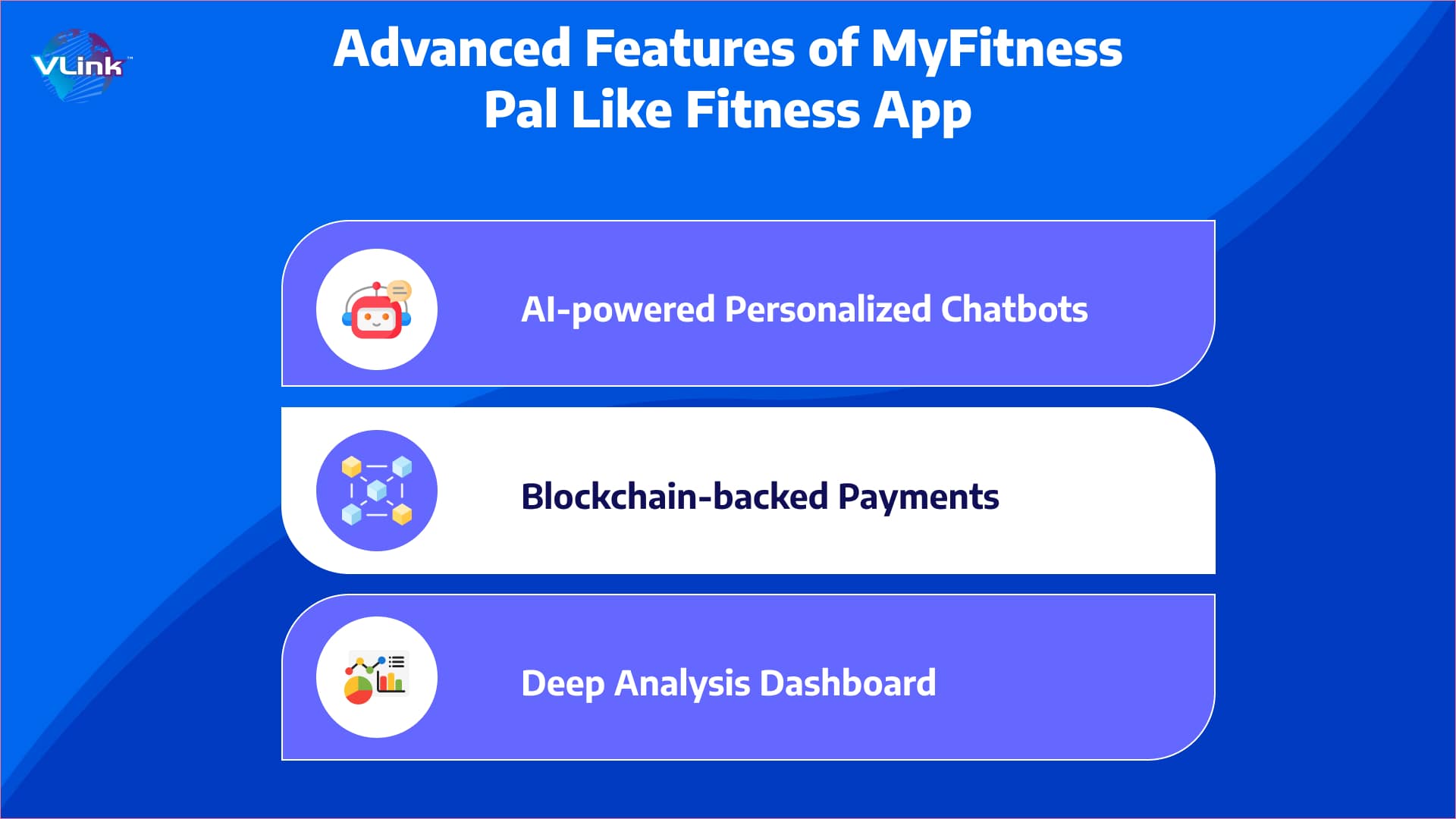
Leverage the capabilities of an AI-powered conversational chatbot to transform the information within your app into a more interactive and engaging format. Explore machine learning and AI development solutions to craft chatbots that serve as the perfect complement to your Fitness app, similar to the enhancements seen in MyFitnessPal.
Ultimately, drawing upon our extensive and profound expertise in blockchain services, we aim to assist you in enhancing the security of the payment system within your application.
User behavior and general browsing patterns within the application generate the data. These dashboards enable you to enhance your comprehension of the data through custom metrics and analytical reports.
How do you Develop a Fitness App like MyFitnessPal?
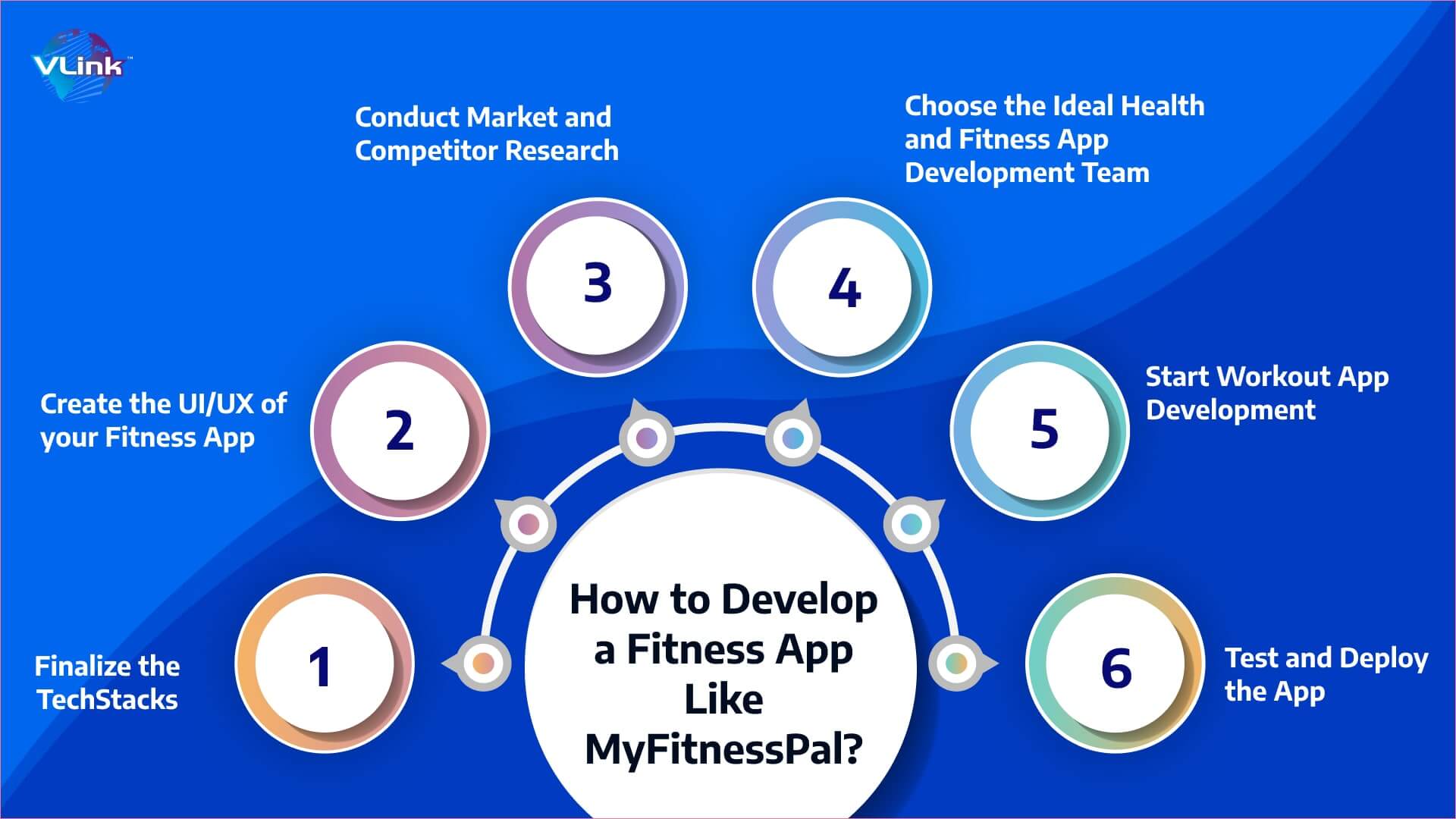
Here are steps to build a fitness app like MyFitnessPal:
In the mobile fitness app, it is imperative to identify a distinctive element that sets your offering apart. Analyze the product offerings, platforms, design intricacies, and customer feedback of your competitors.
Both favorable and unfavorable customer reviews are available on Google Play and the App Store, offering valuable insights into the strengths and weaknesses of your competitors. This analysis can guide you in establishing unique features that differentiate your app from others in the market.
The importance of your app lies in its design, as it attracts users and inspires them to engage. Crafting an exceptional app design involves the UX/UI designer comprehensively analyzing your app requirements. It leads to the development of a general design, wireframe, and prototype for your fitness app.
Standing out from the competition is achievable with a proficient and seasoned team by your side. While having an in-house team is a commendable approach, it requires time and substantial investment.
Alternatively, you can leverage technological expertise by outsourcing the project to firms such as VLink. With a robust and innovative development team, we can grasp your concept and transform it into a tangible reality.
There are various technology stacks, such as the development of the MEAN stack and the MERN stack. You need to select the one that best suits your fitness mobile app development project.
Beyond examining features and competitors, prioritize the crucial aspect of hiring seasoned fitness app developers. Seek out a dedicated development team equipped with the experience, expertise, and foresight necessary to construct an exceptional app that distinguishes itself from others.
This adept team can guide you in initiating your project from its inception, even when requirements are ambiguous, and the scope of work evolves, ensuring the transformation of your vision into a tangible reality.
After completion of the design phase, the critical step involves commencing the development process. It includes coding for the application, incorporating essential features and functionalities, and conducting thorough testing to verify the correct functioning of the application.
The duration of the development process varies and may extend over several months, contingent upon the complexity of the application and the inclusion of features.
Before launching your app, a comprehensive testing phase is crucial to identify and address any bugs or issues. It involves testing the app across various devices and platforms to guarantee its proper functionality and maintain a consistent user experience across all devices.
Following different testing services and resolution of any identified issues, the subsequent step involves deploying the app to the designated app stores. It encompasses submitting the app to either the Google Play Store or iOS App Store and implementing promotional strategies to attract users.
What is MyFitnessPal like Fitness App Development Cost?
The cost to build a mobile app like MyFitnessPal can vary based on several factors. Factors influencing the cost include the app's complexity, features, design intricacy, and development team rates.
Generally, a basic fitness app with standard features may cost around $40,000 to $60,000. In contrast, a more advanced app with additional features like real-time tracking, AI integration, and personalized recommendations can range from $70,000 to $120,000 or more.
Key components impacting costs include:
Features: The inclusion of features such as goal tracking, nutrition plans, social sharing, and integration with wearables or external devices adds to development costs.
Design: A well-designed and user-friendly interface contributes to costs, as a more intricate design requires additional development time.
Platform: Developing for iOS, Android, or both affects costs, with iOS typically being more expensive due to the need for fewer device adaptations.
Backend Development: Building a robust backend infrastructure for data storage, user accounts, and analytics also influences costs.
Engaging an experienced development team, whether in-house or outsourced, contributes to a successful and cost-effective development process.
Create a Robust Fitness App with VLink!
VLink stands out as a premier fitness app development company, crafting state-of-the-art fitness apps with seamless experiences to ensure sustained user engagement and motivation.
Our fitness and wellness mobile app development solutions elevate your business, leveraging extensive expertise in sports software development. We deploy cutting-edge technology to aid you in developing, monetizing, and supporting your fitness solution.
Our highly skilled dedicated team caters to a diverse range of professionals in the fitness field, including Gym Owners, Personal Fitness Trainers, Yoga Gurus, and Dietitians.









 Shivisha Patel
Shivisha Patel
















